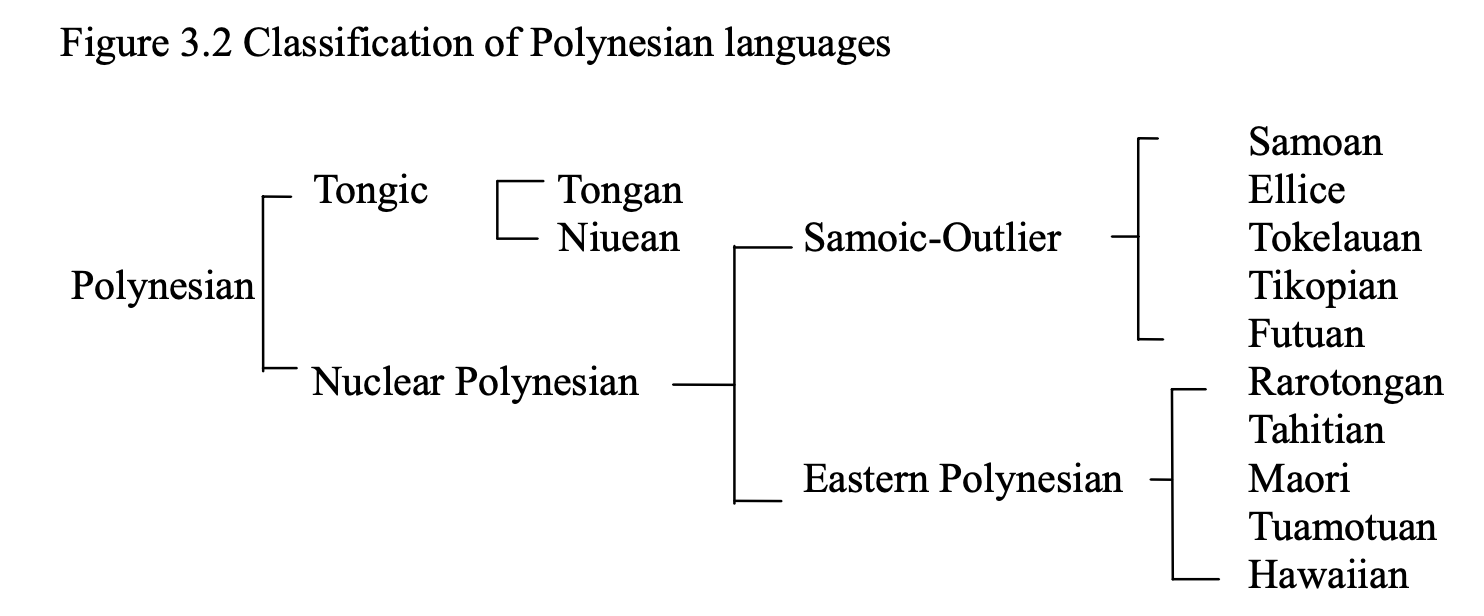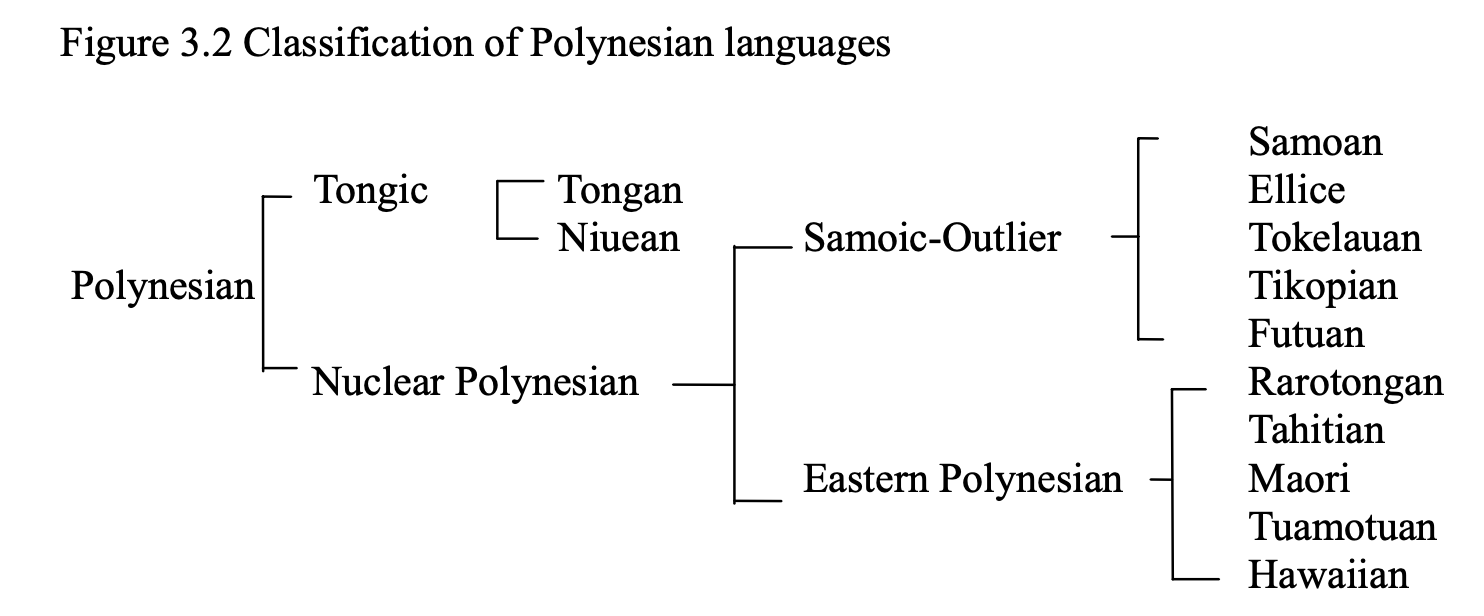Sāmoa Language Week
Comparing some Sāmoan language sentence structures to the equivalent Māori language structures for Samoan Language Week.

It's Sāmoa Language Week in New Zealand this week so I thought it would be interesting to compare some Sāmoan language sentence structures with Māori language sentence structures.
Please note the disclaimer at the end of the article and investigate the list of references there for more authoritative information.
Both the Sāmoan and Māori languages are Austronesian languages which means they have some similar features. Sāmoan (and other Western pacific languages) split off from the language base that it shares with Māori a long time ago so Māori differs from Sāmoan to a greater extent than languages like Tahitian or Cook Island Māori.
The diagram below is from chapter 3 of a thesis by Yuko Otsuka, titled "Ergativity in Tongan". It shows a "family tree" of some of the Polynesian languages, which demonstrates where Samoan sits in comparison to Māori.

In this post I'll compare verb sentences. To talk about verb sentences we need some verbs. In the table below are some verbs in Sāmoan and the Māori equivalents.
| Sāmoa | Māori | English |
|---|---|---|
| moe | moe | to sleep |
| 'ai | kai | to eat |
| savali | hīkoi | to walk |
| nofo | noho | to sit |
The apostrophe in the Sāmoan equivalent for "kai" is a glottal stop. This means "'ai" would be pronounced like "ai" but with a sharper start/stress to the "a".
We'll also be using some personal pronouns. Things get a little more complicated here so I'll only look at the singular pronouns - the equivalent of "I", "You" and "He/She".
In Sāmoan there are two versions of these pronouns. They are the "emphatic pronouns" and the "descriptive pronouns". Emphatic pronouns are used in the subject of sentences where you are placing the emphasis on who is doing the action, whereas descriptive pronouns are used when the emphasis is more on what is being done than who is doing it.
We'll look at the descriptive pronouns as this more closely matches the meaning of simple active sentences in Māori.
| Sāmoa | Māori | English |
|---|---|---|
| 'ou | au | I/me |
| 'e | koe | You |
| na | ia | He/She/It |
Descriptive pronouns can only be used as the subject of sentences. Pronouns in other parts of the sentence (as the object for example) would need to use the emphatic pronouns.
Action Sentences using Descriptive Pronouns
Simple action sentences in Māori following a pattern of "<tense marker> + <verb> + <subject>". I wrote a post on this a while back, Types of Verbs in Te Reo Māori.
In Sāmoan, simple action sentences that use descriptive pronouns follow the pattern "<tense marker> + <subject> + <verb>".
Notice that the subject of the sentence, the do-er, comes after the tense marker and before the verb. This is quite different from te reo Māori! Let's look at some examples then go into detail. Try and work out which parts of the Sāmoan sentence are the verb, subject and tense marker.
| Sāmoa | Māori | English |
|---|---|---|
| Na 'ou moe | I moe au | I slept |
| 'Olo'o 'e 'ai | Kei te kai koe | You are eating |
| 'Ua na savali | Kua hīkoi au | I have walked |
| 'Olē'ā 'ou nofo | Ka noho au | I will sit |
| 'ou te 'ai | Ka kai au | I eat |
Past Tense
The following table shows the pattern for an action that occurred in the past and has been completed, with the verb "to sleep" as an example:
| Sāmoa | Māori | English |
|---|---|---|
| <tense> <subject> <verb> | <tense> <verb> <subject> | <subject> <conjugated verb> |
| Na <subject> <verb> | I <verb> <subject> | <subject> <conjugated verb> |
| Na <subject> moe | I moe <subject> | <subject> slept |
| Na 'ou moe | I moe au | I slept |
Present Tense
The following table shows the pattern for an action that is currently occurring and is ongoing. It uses "to eat" as the verb for an example.
Note that to express present tense in te reo Māori we use "Kei te" or "E ... ana" as the tense marker. I'm going to use "Kei te" for this post.
| Sāmoa | Māori | English |
|---|---|---|
| <tense> <subject> <verb> | <tense> <verb> <subject> | <subject> <conjugated verb> |
| 'Olo'o <subject> <verb> | Kei te <verb> <subject> | <subject> am/is/are <verb>-ing |
| 'Olo'o <subject> 'ai | Kei te kai <subject> | <subject> is eating |
| 'Olo'o 'e 'ai | Kei te kai koe | You are eating |
The tense marker "Kei te" in Māori expresses present tense, but also expresses that the action is continuous - basically what the "-ing" verb ending in English expresses. The "'O'lo'o" tense marker in Sāmoan also expresses this continuous aspect.
Past Perfect Tense
Past Perfect tense is the equivalent of "have/has" sentences in English. These types of sentences express an action that has been completed in the past but has relevance for the current time, or another expressed time. In Māori we use "Kua" for this. The table below demonstrates the pattern using "to walk" as the verb.
| Sāmoa | Māori | English |
|---|---|---|
| <tense> <subject> <verb> | <tense> <verb> <subject> | <subject> <conjugated verb> |
| 'Ua <subject> <verb> | Kua <verb> <subject> | <subject> have/has <verb>-ed |
| 'Ua <subject> savali | Kua hīkoi <subject> | <subject> have/has walked |
| 'Ua na savali | Kua hīkoi au | I have walked |
The similarity in the Sāmoan word "'ua" to the Māori word "kua" matches the similarity in "'ai" vs "kai".
Future Tense
To express future tense in te reo Māori we can use "Ka". The situation with "ka" is actually a bit more complex than "future tense" as it can express other tenses. It picks up the tense from a context already established, like using "āpōpō" or some other time marker. For these examples, imagine the tense has already been established with a future time marker. The pattern for these sentences using the verb "to sit" is below.
| Sāmoa | Māori | English |
|---|---|---|
| <tense> <subject> <verb> | <tense> <verb> <subject> | <subject> <conjugated verb> |
| 'Olē'ā <subject> <verb> | Ka <verb> <subject> | <subject> will <verb> |
| 'Olē'ā <subject> nofo | Ka noho <subject> | <subject> will sit |
| 'Olē'ā 'ou nofo | Ka noho au | I will sit |
Habitual
There is a tense marker in Sāmoan that is used to indicate habitual, or implied future. This is used to say things like "I go to the hospital", or when answering "I eat" to the question "What do you do when you're hungry?".
For those sentences that use descriptive pronouns, the Sāmoan tense marker is "te" and it is structured differently in that the subject appears before the tense marker.
In Māori we'd often use "habitual ai" for the habitual tense, but "ka" can also be used for the general case above when answering the question with "I eat". The table below shows this pattern.
| Sāmoa | Māori | English |
|---|---|---|
| <subject> <tense> <verb> | <tense> <verb> <subject> | <subject> <conjugated verb> |
| <subject> te <verb> | Ka <verb> <subject> | <subject> <verb> |
| <subject> te 'ai | Ka kai <subject> | <subject> eat |
| 'ou te 'ai | Ka kai au | I eat |
Conclusion
This has been a very brief look at one small aspect of Sāmoan and how it compares to Māori - using Māori as a hook to learn a bit of Sāmoan. I encourage you to try this process during the various language weeks, or any other time, as a way to learn a bit more about the Pacific world.
I sometimes hear an argument from people who don't want to learn Māori that it is a waste of time, no body speak it, or it would be better to learn languages like French or Mandarin.
My thinking is that we live in the pacific, we are surrounded by other pacific cultures and languages. The Māori language is a close cousin to these languages, and learning Māori makes the task of learning these languages a bit easier.
While on the surface Sāmoan and Māori seem quite different, we see shared words, the use of tense markers instead of conjugation to express tense, and similar pronunciation. I'm far more likely to hear Sāmoan, Tongan or Māori than other languages in the spaces I inhabit.
Many of the romance languages (French, Spanish, etc) are easier to pick up because we know English. Learning Māori early, alongside English, enables picking up the Pacific languages easier, and the romance languages through English.
Learning Māori and other Pacific languages enables us to learn more about the culture and understand better our near neighbours.
Disclaimer and References
My understanding of Sāmoan prior to looking into it for Sāmoa Language Week was low. Most of what I've written is here is from things I've learnt while exploring various resources, listed below, my knowledge of te reo Māori and some knowledge of Tongan. My apologies for any errors and I welcome corrections and feedback in the comments.
Thanks to the following references:
- Sāmoan Verb Resource at samoan.ws
- Gagana Sāmoa by Galumalemana Afeleti Hunkin.
- Sāmoan Language YouTube Channel.
